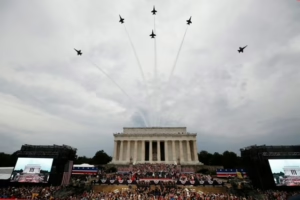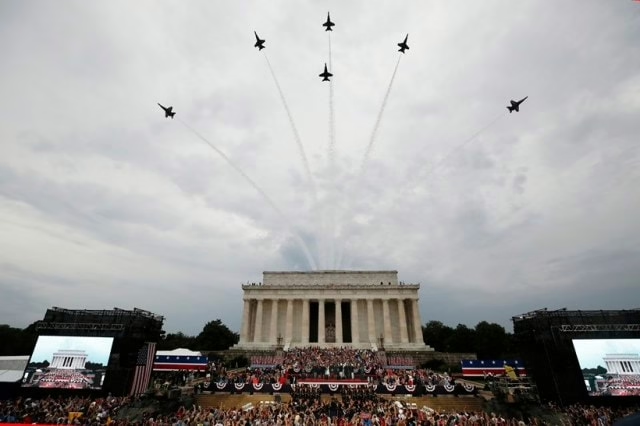
Why is 4th of July Celebrated as US Independence Day? The 4th of July, also known as Independence Day, is a significant national holiday in the United States. It commemorates the adoption of the Declaration of Independence on July 4, 1776, which marked the country’s formal separation from Great Britain. This day is celebrated with a variety of festivities, including fireworks, parades, barbecues, and patriotic displays. Understanding the history and significance of the 4th of July provides insight into the values and heritage of the United States.
Historical Background
The road to American independence was paved with a series of events and ideological shifts that culminated in the Declaration of Independence.
Colonial America and British Rule
In the early 17th century, settlers from England established the first permanent colonies in North America. Over time, thirteen colonies were established along the eastern seaboard. These colonies were governed by British law and were subject to British taxes and trade regulations. However, as the colonies grew in population and economic power, tensions began to rise over issues of governance and representation.
The Prelude to Independence
Several factors contributed to the growing desire for independence among the American colonists:
- Taxation Without Representation: The British government imposed a series of taxes on the colonies, including the Stamp Act (1765) and the Townshend Acts (1767), without granting them representation in the British Parliament. This led to widespread resentment and the rallying cry of “no taxation without representation.”
- The Boston Massacre and Boston Tea Party: In 1770, British soldiers killed five colonists in what became known as the Boston Massacre. Three years later, in response to the Tea Act, which granted the British East India Company a monopoly on tea sales in the colonies, colonists staged the Boston Tea Party, dumping an entire shipment of tea into Boston Harbor as an act of protest.
- Intolerable Acts: In response to the Boston Tea Party, the British government passed the Coercive Acts (known as the Intolerable Acts in the colonies) in 1774. These laws restricted colonial self-government and increased British control, further inflaming tensions.
The Continental Congress
In response to these grievances, colonial leaders convened the First Continental Congress in 1774. This assembly of delegates from twelve of the thirteen colonies aimed to coordinate a response to British policies. The Congress petitioned King George III for redress of their grievances but prepared for potential armed conflict by establishing local militias.
The situation escalated in April 1775 when British troops and colonial militiamen clashed at the Battles of Lexington and Concord. These skirmishes marked the beginning of the American Revolutionary War.
The Declaration of Independence
By 1776, the call for independence had gained considerable support among the colonists. The Second Continental Congress, which convened in May 1775, took on the task of steering the colonies through the war and debating the question of independence.
Drafting the Declaration
On June 7, 1776, Richard Henry Lee of Virginia presented a resolution to the Continental Congress declaring that the colonies “are, and of right ought to be, free and independent States.” The Congress appointed a committee to draft a formal declaration of independence. This committee included Thomas Jefferson, John Adams, Benjamin Franklin, Roger Sherman, and Robert R. Livingston, with Jefferson serving as the principal author.
Adoption and Signing
After several weeks of debate and revisions, the Continental Congress officially adopted the Declaration of Independence on July 4, 1776. The document articulated the colonies’ reasons for seeking independence and outlined the philosophical justification for self-governance. It famously begins with the preamble:
“We hold these truths to be self-evident, that all men are created equal, that they are endowed by their Creator with certain unalienable Rights, that among these are Life, Liberty and the pursuit of Happiness.”
The Declaration was signed by 56 delegates, representing the thirteen colonies. The act of signing was both a bold statement of defiance against British rule and a unifying moment for the colonies.
The Revolutionary War
The adoption of the Declaration of Independence did not immediately end British rule. The Revolutionary War continued for several more years, with key battles such as the Battle of Saratoga in 1777 and the Siege of Yorktown in 1781 shaping the outcome. The war officially ended with the Treaty of Paris in 1783, in which Britain recognized the sovereignty of the United States.
The Significance of Independence Day
National Identity and Unity
The 4th of July is more than just a commemoration of a historical event; it represents the birth of a nation founded on principles of liberty, equality, and self-determination. It is a day when Americans come together to celebrate their shared values and national identity.
Patriotic Celebrations
Independence Day is marked by a variety of patriotic traditions and celebrations:
- Fireworks: One of the most iconic symbols of the 4th of July, fireworks displays light up the night sky in cities and towns across the country. These displays are a visual representation of the “rockets’ red glare” mentioned in the national anthem, “The Star-Spangled Banner.”
- Parades: Many communities hold parades featuring marching bands, floats, military units, and local organizations. These parades celebrate the nation’s history and showcase local pride.
- Barbecues and Picnics: The 4th of July is a popular time for family gatherings, barbecues, and picnics. Traditional foods such as hot dogs, hamburgers, and apple pie are often enjoyed.
- Patriotic Music: Songs like “God Bless America,” “America the Beautiful,” and “The Star-Spangled Banner” are performed at events and gatherings, reinforcing a sense of national pride.
Reflection and Remembrance
In addition to celebrating, Independence Day is also a time for reflection on the sacrifices made by those who fought for the nation’s independence and the ongoing struggle to uphold its founding principles. It serves as a reminder of the values that underpin American democracy and the importance of civic engagement.
The Evolution of Independence Day Celebrations
Early Observances
The first celebrations of Independence Day were modest compared to today’s festivities. In the early years, public readings of the Declaration of Independence, bonfires, and the ringing of bells were common ways to mark the occasion.
19th Century Changes
As the United States expanded and developed, Independence Day celebrations grew in scope and scale. The holiday became a time for public events, speeches, and military displays. By the mid-19th century, fireworks had become a central part of the celebrations.
Modern Celebrations
Today, the 4th of July is celebrated with a blend of traditional and contemporary customs. While fireworks and parades remain popular, modern technology has introduced new ways to celebrate, such as televised events, digital displays, and social media campaigns.
Cultural Significance
Independence Day has also taken on cultural significance, reflecting the diverse and evolving nature of American society. The holiday is a time for Americans of all backgrounds to express their patriotism and celebrate their contributions to the nation’s history and culture.
Conclusion
The 4th of July stands as a testament to the enduring spirit of freedom and independence that defines the United States. It is a day to honor the vision and courage of the nation’s founders, to celebrate the achievements and diversity of its people, and to recommit to the principles of liberty and justice for all. As Americans gather to enjoy fireworks, parades, and picnics, they also reflect on the sacrifices that have been made to secure their freedoms and the responsibilities that come with maintaining them. Independence Day is not just a historical milestone; it is a living tradition that continues to inspire and unite the nation.

